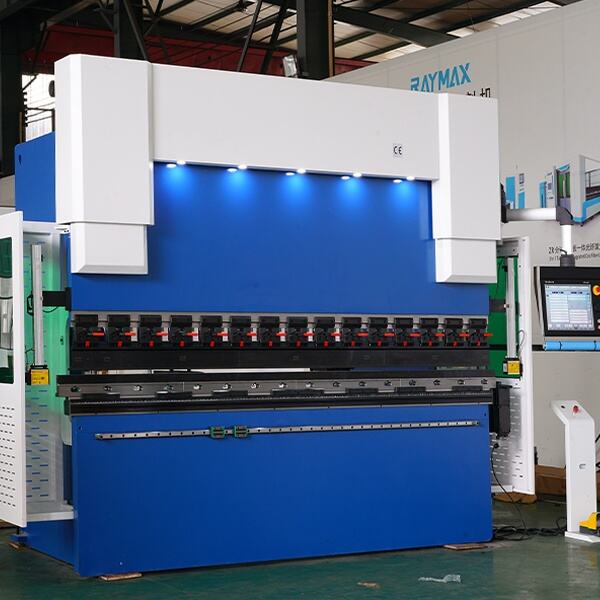Understanding Multi-Axis Control in CNC Press Brakes
Defining Multi-Axis Functionality
CNC press brakes with multi-axis control are changing how sheet metal gets fabricated these days, bringing about better precision and faster work rates. These machines have several key axes working together Y, X, R, and Z each doing something important for getting those bends just right. Take the Y-axis for example it moves the ram up and down which sets the actual bend angle. Then there's the X-axis that controls where the back gauge sits so flanges come out at the correct length every time. The R-axis raises or lowers the back gauge itself to give proper support during bending operations. And finally, the Z-axis lets those back gauge fingers move side to side, making it possible to handle all sorts of complicated shapes without constant readjustments. With all these moving parts working in harmony, shops spend way less time tweaking things manually, which cuts down on mistakes made by hand. Operators end up with more free time to tackle other jobs while still maintaining high quality standards across production runs. For manufacturers looking to streamline their processes and save money in the long run, investing in multi-axis controlled press brakes makes a lot of sense when considering both product consistency and overall shop productivity.
How Hydraulic CNC Press Brakes Enhance Precision
Hydraulic CNC press brakes really boost precision in sheet metal work because they have better control systems. When operating these machines, the hydraulic system moves smoothly and responds quickly, so every bend comes out just right. Studies show that compared to older models, these CNC versions can make bends about 50% more accurate when doing lots of repeats. For industries that need parts to fit together perfectly like cars or planes, this kind of accuracy makes all the difference. Shops that switch to hydraulic CNC presses usually see fewer rejects and less wasted material since the machines consistently produce parts within spec. While many manufacturers talk about staying current with technology, investing in these machines actually delivers real results in terms of product quality and bottom line savings over time.
Core Axes and Their Functions in Bending Operations
Y-Axis: Ram Movement and Bend Accuracy
The Y-axis on a CNC press brake plays a key role in controlling the ram's up and down motion, which directly affects how accurately bends are made during operation. When manufacturers get this axis right, they can consistently hit those target angles every time, something that matters a lot when making quality parts. Take a standard shop floor situation for example. Most machines these days have what's called a dual Y1/Y2 setup. This lets each side of the ram move independently, so even long pieces stay properly bent along their whole length without warping issues. Industry experts point out that better control over this Y-axis stuff actually makes shops run faster because there's less waste from messed up bends in mass production runs.
X-Axis: Backgauge Positioning for Flange Control
Getting the X-axis right makes all the difference for proper backgauge placement on those CNC press brakes, which keeps flange lengths consistent across different part designs. When manufacturers get this positioning spot on, they end up with parts that have matching flange measurements even when working on complex shapes. The X-axis really shines when handling things like tapers or complicated geometries, since it allows separate control over those gauge stop fingers we call X1 and X2. Industry insiders know that better X-axis performance typically cuts down production times somewhere around 20 percent, which speaks volumes about how important this feature is for day to day shop operations.
R-Axis: Vertical Adjustment and Material Support
The R-axis gives important vertical movement options that keep materials stable while they're being bent, which cuts down on warping problems. When dealing with different sized and weighted materials, this feature really shines because it lets those little gauge fingers move up and down as needed. Materials stay put much better, especially when there are already formed edges or when lifting heavier components becomes necessary. Most shops will tell anyone who asks that the R-axis isn't just nice to have but essential for getting those extra positioning points that stop mistakes from happening during material handling operations. Without it, things tend to go sideways pretty quickly.
Z-Axis: Lateral Gauge Finger Movement
The Z axis controls side to side movement of those gauge fingers that position parts correctly when doing bends. Getting this right makes all the difference for setting up jobs accurately on the machine. When technicians tweak the Z axis settings, they save loads of time on repeat bending jobs because there's less messing around with tool changes between setups. Some studies published in manufacturing journals actually show that good control over the Z axis can boost productivity anywhere from 10% to 15% in shops using CNC press brakes regularly. This matters a lot in busy fabrication environments where every minute counts toward meeting deadlines.
Advantages of Multi-Axis CNC Press Brakes
Improved Precision for Complex Geometries
When it comes to creating complex shapes that regular machines just can't handle, multi-axis CNC press brakes stand out as game changers. These machines give operators control across several axes at once, allowing them to form intricate parts with remarkable precision. Industries like aerospace manufacturing, car production, and specialty metalwork rely heavily on this technology because nothing else matches its capability for tricky bends and curves. Shop floor workers who deal with these systems day in and day out will tell anyone willing to listen how much better they are at keeping measurements consistent compared to older methods. Looking at actual shop results shows something pretty clear too the error rates drop dramatically when shops switch to multi-axis systems, which means fewer rejected parts and happier customers overall.
Enhanced Productivity with Automated Adjustments
Multi axis CNC press brakes bring major gains in productivity because they speed up those long production cycles so much. The machines automatically adjust themselves during the bending process, which cuts down on how often operators need to step in manually. This means less time wasted when something goes wrong or needs fixing. For manufacturers trying to keep up with increasing orders, scaling production becomes much easier without losing that all important efficiency factor. A number of shops actually saw their output jump after installing these multi axis systems, proving just how game changing automated CNC technology has become across today's manufacturing landscape.
Versatility Across Material Thicknesses and Shapes
Multi axis CNC press brakes stand out because they work well with all sorts of materials and thicknesses like aluminum, steel, and even tough stainless steel. The fact that these machines can handle so many different jobs means factories don't need separate equipment for each material type, which saves money and space on the shop floor. Most industry publications point out how adaptable these presses really are when it comes to meeting varied production demands across sectors. Practical tests show they handle both thin sheet metal pieces and thick industrial steel plates just fine, which explains why so many shops keep investing in these machines despite their higher upfront costs compared to simpler alternatives.
Determining the Right Number of Axes for Your Needs
Assessing Part Complexity and Tolerance Requirements
Picking out the right CNC press brake starts with looking at what kind of parts need to be made. The axis count matters a lot when it comes to handling complicated shapes and getting those tight tolerances right. Parts that are really intricate usually need machines with several axes just to get them accurate enough and repeatable across production runs. Take aerospace and automotive manufacturing for instance both fields where even small errors can have big consequences. These sectors rely heavily on press brakes that come with extra axes because their specs don't allow for much margin of error. The aerospace field especially stands out here since every component must meet strict standards. That's why we see so many shops in this area investing in CNC press brakes with multiple axes they simply cannot afford anything less if they want to maintain the level of precision required for aircraft parts.
Balancing Budget and Operational Efficiency
Getting the right mix of price and what the machine can actually do matters a lot when looking at multi axis press brakes. Sure, fancy setups come with better production power, but businesses need to figure out if spending that much money now really fits what they want to accomplish operationally. Looking at all the expenses over time makes sense too maintenance costs plus how much faster things get done. Some companies find ways around this problem through equipment leases or buying machines that can be upgraded piece by piece as needed. Most industry pros recommend comparing how much extra work gets done versus what was paid upfront before making any big purchases. There are different ways to calculate money saved in the future from having those efficiency boosts that come with multi axis systems.
Key Considerations When Upgrading to Multi-Axis Control
Evaluating CNC Press Brake Suppliers
Upgrading to multi axis CNC press brakes means taking time to look at possible suppliers through the right lens. Reputation matters a lot here, along with what kind of after sales help they offer and how much support comes with their products. A good working relationship with these suppliers goes beyond just talking business it actually makes sure their machines fit into existing workflows without causing headaches down the road. Most folks in this field check things like how well machines perform over time, how fast tech support responds when problems pop up, and what other customers have said about their experiences. All these factors together give a pretty clear picture of who might be the right match for someone looking to upgrade their equipment setup.
Training Operators for Advanced Functionality
Getting skilled operators on board is really important when it comes to getting the most out of those upgraded multi-axis CNC press brakes. There are plenty of training courses and certification options around that can help operators level up their game and get comfortable with all the new features these machines offer. When operators receive proper training, several good things happen. Error rates tend to drop off quite a bit, the work becomes much more precise, and the machines themselves last longer without breaking down so often. Companies start seeing better productivity numbers after a while too. The money saved from fewer breakdowns and repairs makes all that investment in training totally worth it in the long run.



